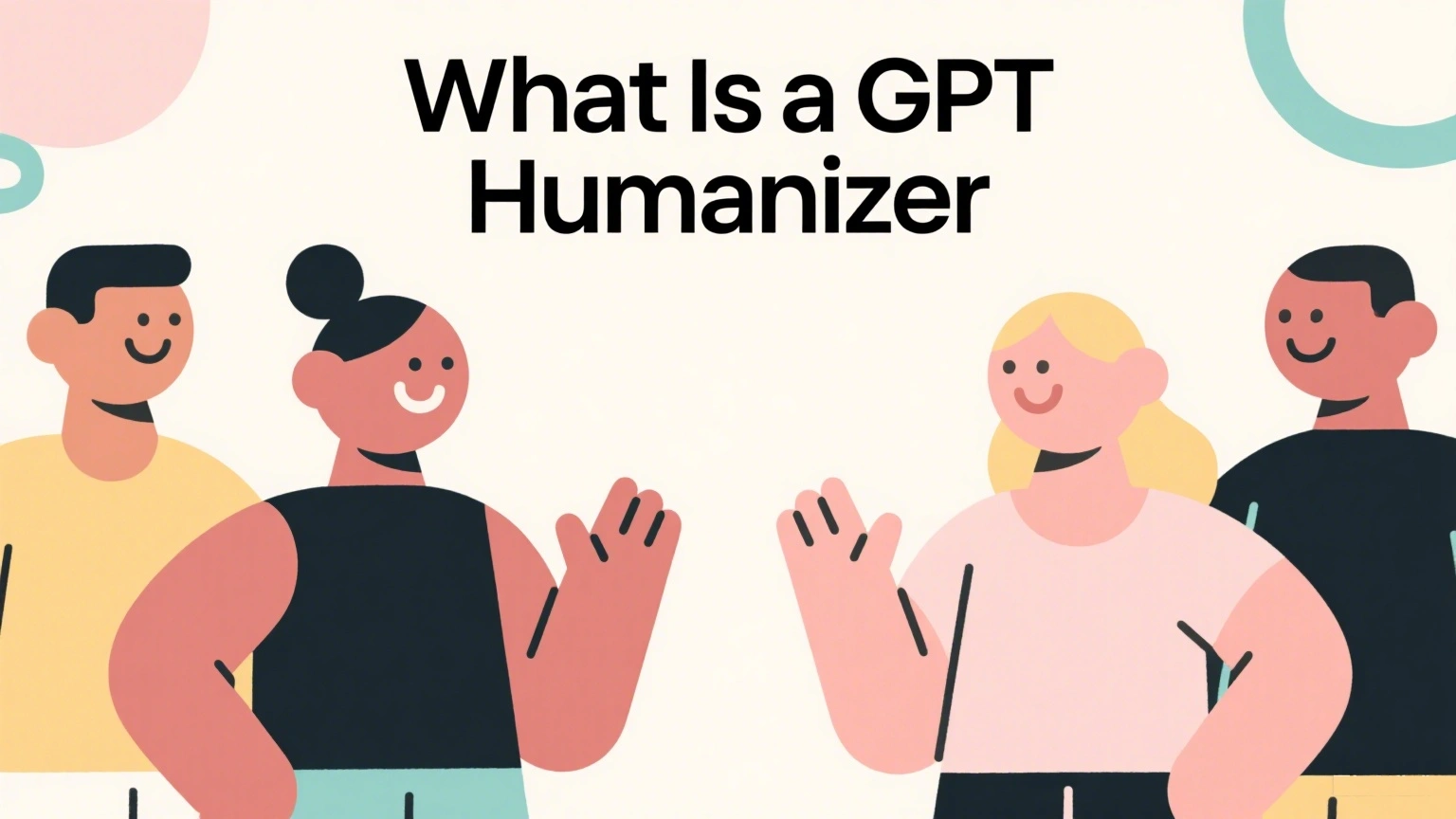What Is a GPT Humanizer? Uses, Limits & Tips

A GPT humanizer is a kind of tool or process that can shape and rewrite AI text to sound like what real people would say. The tool can make the tone clearer, make each sentence flow in a different way, and remove certain robotic writing patterns—again without changing what you mean to say. When you use ChatGPT, Gemini, or Claude to draft something, a great chat GPT humanizer enables you to tweak the stiffness and flow so your article, email blast, or product page reads naturally to an actual person. Reputable vendors frame this as readability and tone improvement (not detector evasion), emphasizing clarity, cohesion, and control over style.
What a GPT humanizer actually does (and doesn’t)
At its best, a humanizer smooths repetition, varies syntax, improves transitions, and preserves intent—think “humanize AI text” rather than “rewrite beyond recognition.” Leading writing assistants describe this as refining clarity, tone, and flow while keeping the author’s meaning intact. That positioning matters, because it aligns with responsible use rather than “100% undetectable” guarantees you’ll often see in ad copy.
Use it responsibly: how this fits Google’s guidance
Google doesn’t ban AI-assisted content; it rewards helpful, people-first pages regardless of production method. Your job is to add real value, show who wrote/edited the piece, and avoid scaled, low-quality pages. In short: publish original insight and maintain E-E-A-T signals; don’t mass-spin posts.
A practical workflow that keeps meaning intact
1. Write a draft. Use your LLM of choice to make a detailed outline and first draft, all coming from a question you have a working knowledge of.
2. Humanize and smooth it out. Use a humanization tool on your draft to get rid of weird words and highly repetitive short sentences while maintaining your main information. Grammarly and QuillBot claim this “refines clarity and readability.” Don’t just “bypass detectors."
3. Edit the facts. Check the facts, add examples, and share your own experience, like why this is important, what to do first, and what not to do.
4. Check grammar and reading. Check if it makes sense, if it uses different sentence length, if the sentences are connected, and if the voice is consistent.
5. Disclose you used AI. If your company, client, or school asks you to say that you used AI, also say what you changed after using AI.
Common mistakes to avoid
● Chasing “undetectable.” No detector is perfect; vendors themselves acknowledge false positives and variability. Treat detectors (and “success-rate” claims) with caution, and don’t optimize solely to “beat” them.
● Over-rewriting the meaning. A humanizer should not distort facts or inject claims you can’t support.
● Publishing thin, scaled pages. If you’re mass-producing content with minimal editing, you risk spam-policy issues and poor user signals.
● Ignoring audience fit. The goal isn’t just “sound human”; it’s to be useful to a specific reader at a specific moment.
When a GPT humanizer helps most
● Marketing and product pages require a consistent tone and an easily readable structure.
● Knowledge material benefits from a mix of sentences and smooth transitions.
● Team projects involve several writers and need consistent and clear language.
Where GPTHumanizer fits (and how to use it compliantly)
If you need to focus on tone while keeping the meaning, GPTHumanizer (gpthumanizer.ai) works well in step 2. chat GPTHumanizer can smooth out robotic text and make it easier to read. After you use it, always check the facts yourself and add real examples. Never use these tools to pretend that AI-generated content came from you, or to cheat on an assignment (or in a workplace context). Follow your organization’s rules and disclose AI help if expected.
FAQ
What is a GPT humanizer?
A chat GPT humanizer rewrites AI-generated text to improve clarity, tone, and flow, while keeping your original meaning. The best-known tools describe this as readability improvement, not “detector evasion.”
Is it ethical to use a GPT humanizer?
Yes—as long as you’re using it to polish your own draft and you follow any applicable policies (e.g., client guidelines, workplace standards, course rules). Most leading tools actively disavow “bypass” claims and emphasize responsible use. When in doubt, disclose.
Does Google penalize AI-assisted content?
Not for being AI-assisted. Google cares about usefulness and quality (E-E-A-T acronym), and has cautioned against scaled low-value content. But if your article actually helps readers and demonstrates expertise, it can rank.
Can a GPT humanizer guarantee “undetectable” AI?
No. AI detectors are prone to false positives and their effectiveness is inconsistent; even the makers warn against over-interpreting scores—especially for low percentages. Consider detector output like plagiarism scores—a signal, not a verdict.
How do I humanize AI text without changing the meaning?
Use a humanizer to smooth tone and rhythm, then do one careful human editorial pass to check facts, restore brand voice, or adjust for audience. Tools have positioned their role as preserving meaning (your intent) while improving readability (their output)—your editorial pass guards nuance.
Want a focused pass that improves tone and readability while preserving intent? Try GPTHumanizer , use it as one step in a transparent, quality-first workflow. And remember: publish for people, not algorithms. That’s how a gpt humanizer delivers real value.
Related Articles

Stealth Writer AI Review 2026: Feature, Pricing & Comparison
Explore Stealth Writer 2026 Ghost Pro & bypass rates and all features. We analyze multi-level models...

QuillBot's AI Humanizer Review 2026: Feature, Pricing & Comparison
Discover if QuillBot's AI Humanizer is right for you in our 2026 review. Explore its features, prici...

HIX Bypass AI Review 2026: Feature, Pricing & Comparison
A detailed and objective 2026 review of HIX Bypass AI covering its features, pricing, rewrite qualit...

GPTinf Review 2026: Feature, Pricing & Comparison
A detailed GPTinf review for 2026 covering features, pricing, strengths and weaknesses, real user fe...
